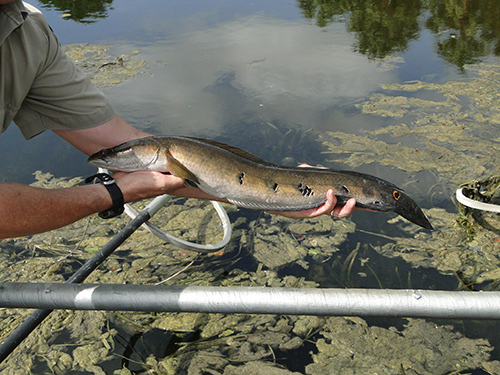Bullseye Snakehead
Origin:
Tropical Asia (Pakistan to southern China, Thailand, Cambodia, and Laos)
Introduction to Florida:
Unknown, perhaps as a foodfish
Stage on Invasion Curve:
Resource Protection and Long-Term Management



Description
The bullseye snakehead (Channa marulius) has a flattened head with large scales, a torpedo-shaped body, long dorsal and anal fins without spines, and toothed jaws. Nearly all adults have a black dot surrounded with red or orange on the top part of the caudal (tail) fin. Most have blotches of dark scales flecked in white along the side of the body. The largest documented bullseye snakehead weighed more than 14 pounds (37 inches) but anglers typically catch ones weighing between 3 and 6 pounds (23–28 inches). The bullseye snakehead resembles the native Florida bowfin (Amia calva), but has a longer anal fin.
Impacts
Bullseye snakeheads are predators that eat a wide range of animals: mainly small fish and crayfish, also cane toads, lizards, snakes, small turtles, and snails. This wide diet helps the bullseye snakehead survive in Florida, but also may reduce its impact on any particular native species. The bullseye snakehead may threaten native fish species through competition for food and habitat, but major impacts have not been documented. They can breathe air (but cannot crawl on land), which may allow them to occupy habitats with poor water quality not suitable for many native fish species.
In places where the snails do not have enough calcium in the environment to build their shells, they have been known to eat the stucco off houses and the paint off cars! When crossing roads at night, adult snails are a hazard to drivers because their large, hard shells can puncture tires. The snails are also considered a public health threat, as their slime is home to the parasitic rat lungworm (Angiostrongylus sp.) which can cause meningitis.
Where to Find Them
Bullseye snakeheads are found in freshwater canals in northern Broward County and southern Palm Beach County. Bullseye snakeheads die at water temperatures below 50 degrees, which limits their distribution to South Florida.
Distribution Maps
What You Can Do
You can help control this exotic fish population!
- Go fishing for bullseye snakehead.
- If you catch one, do not release it! Immediately place it on ice or humanely euthanize it.
- Eat it! Bullseye snakehead is good to eat and has a mild taste.
- Report your bullseye snakehead catches to the FWC:
- Call the Exotic Species Hotline, 888-Ivegot1 (888-483-4681)
- Report online: www.IveGot1.org
- Email: ExoticFreshwaterFishID@myfwc.com
- Take a picture with your phone, and note the location.
- Call 1-888-397-1517 to report snail sightings.
- Always wash your hands and produce before consumption.
- Do not move plants or plant material from areas infested with the snail.
More Information
- Bullseye Snakehead and Bowfin: How to Tell the Difference
- http://myfwc.com/wildlifehabitats/profiles/freshwater/nonnatives/bullseye-snakehead/






